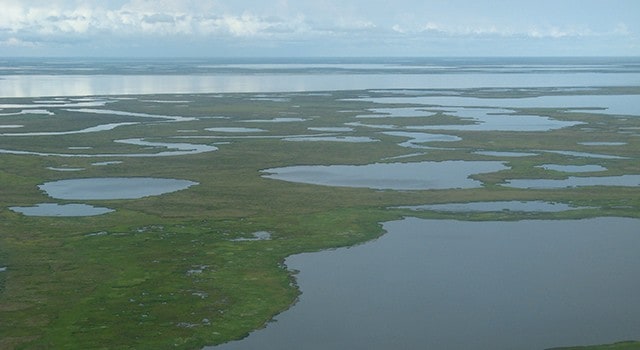As climate change grips the Arctic, how much carbon is leaving its thawing soil and adding to Earth’s greenhouse effect? The question has long been debated by scientists. A new study conducted as part of NASA’s Carbon in Arctic Reservoirs Vulnerability Experiment (CARVE) shows just how much work still needs to be done to reach a conclusion on this and other basic questions about the region where global warming is hitting hardest.
Lead author Josh Fisher of NASA’s Jet Propulsion Laboratory, Pasadena, California, analyzed 40 computer models of the amounts and flows of carbon in the Alaskan Arctic and boreal ecosystems. His team found wide disagreement among the models, highlighting the urgent need for more measurements from the region.
Models represent scientists’ integrated understanding of Earth processes and systems. They are used both to test that understanding, by comparing their results with real-world observations, and to gain insight into how current trends may affect our planet’s future.
“We all knew there were big uncertainties in our understanding, and we wanted to quantify their extent,” said Fisher. That extent proved to be greater than almost anyone expected. “The results were shocking to most people,” he said.
However, pinpointing the extent and areas of uncertainty is the first step toward reducing them. Fisher noted that he has shared preliminary results with the modelers who participated in the study, and some have already used the results as an opportunity to rethink how they are representing Arctic processes in global models. Moreover, the uncertainty maps that the study produced, showing the specific Arctic regions where the disagreement is greatest, highlight key locations for field campaigns to collect data.
The study, which involved 30 co-authors from around the world, examined how well the models agreed on various factors, such as the rate of plant growth and the amount of carbon exchanged between living things and the atmosphere. They also evaluated the performance of the models against measurements of carbon at monitoring sites along the tundra of the Alaskan North Slope.
“If all the models agree with the observations, uncertainty is probably pretty low. If they wildly disagree, uncertainty is pretty high,” Fisher said. “The models were all over the board.”
Fisher stressed that all of these models “are perfectly valid representations of what’s going on in the Arctic.” Without more real-world measurements, it’s not possible to be sure which comes closest to reality.
Scientists urgently want to understand the state of Arctic carbon because there are huge stores of carbon from dead vegetation locked in permafrost — and permafrost is turning out not to be as permanently frozen as its name implies. With the Arctic warming much faster than the rest of the planet, permafrost is thawing. Those carbon stores could be released into the atmosphere either slowly or in a giant burst, further accelerating the pace of climate change.
“We’re opening Pandora’s box by warming the permafrost,” Fisher said. “In the Amazon, if you cut down a tree and release carbon to the atmosphere, you can plant another tree that will reabsorb that lost carbon. In the Arctic, the carbon stored in permafrost represents millennia of accumulated dead vegetation. If you lose that carbon to the atmosphere, you can’t get it back that easily.”
But more carbon dioxide in the air and longer growing seasons due to global warming promote more plant growth, and plants remove carbon from the air during photosynthesis. Some models suggest that the carbon removed by plants could balance the carbon released by permafrost thaw.
That’s one of the questions that CARVE principal investigator Charles Miller of JPL hopes the campaign will help modelers to answer. “Ultimately, we hope the CARVE data can be used to diagnose the strengths and weaknesses of different models and to improve the representation of carbon cycling in Alaska and throughout the Arctic,” Miller said.
“The general feeling is that the Arctic will be a big source of carbon to the atmosphere, but the uncertainty is a little too high to say for sure,” Fisher said. “CARVE measurements will quantify the present-day carbon sources and help to reduce that uncertainty.”


